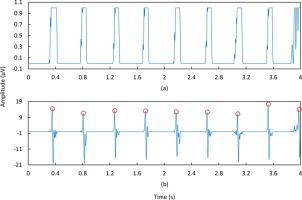IRBM ( IF 5.6 ) Pub Date : 2019-12-19 , DOI: 10.1016/j.irbm.2019.12.002 Y.S. Alshebly , M. Nafea

|
Objective
Monitoring the heartbeat of the fetus during pregnancy is a vital part in determining their health. Current fetal heart monitoring techniques lack the accuracy in fetal heart rate monitoring and features acquisition, resulting in diagnostic medical issues. The demand for a reliable method of non-invasive fetal heart monitoring is of high importance.
Method
Electrocardiogram (ECG) is a method of monitoring the electrical activity produced by the heart. The extraction of the fetal ECG (FECG) from the abdominal ECG (AECG) is challenging since both ECGs of the mother and the baby share similar frequency components, adding to the fact that the signals are corrupted by white noise. This paper presents a method of FECG extraction by eliminating all other signals using AECG. The algorithm is based on attenuating the maternal ECG (MECG) by filtering and wavelet analysis to find the locations of the FECG, and thus isolating them based on their locations. Two signals of AECG collected at different locations on the abdomens are used. The ECG data used contains MECG of a power of five to ten times that of the FECG.
Results
The FECG signals were successfully isolated from the AECG using the proposed method through which the QRS complex of the heartbeat was conserved, and heart rate was calculated. The fetal heart rate was 135 bpm and the instantaneous heart rate was 131.58 bpm. The heart rate of the mother was at 90 bpm with an instantaneous heart rate of 81.9 bpm.
Conclusion
The proposed method is promising for FECG extraction since it relies on filtering and wavelet analysis of two abdominal signals for the algorithm. The method implemented is easily adjusted based on the power levels of signals, giving it great ease of adaptation to changing signals in different biosignals applications.
中文翻译:

小波分析从腹部心电图分离胎儿心电图信号
目的
在怀孕期间监视胎儿的心跳是确定胎儿健康的重要组成部分。当前的胎儿心脏监测技术缺乏胎儿心率监测的准确性和特征获取,从而导致诊断医学问题。对可靠的无创胎儿心脏监测方法的需求非常重要。
方法
心电图(ECG)是一种监视心脏产生的电活动的方法。从腹部ECG(AECG)提取胎儿ECG(FECG)具有挑战性,因为母亲和婴儿的ECG共享相似的频率分量,从而增加了信号被白噪声破坏的事实。本文提出了一种通过使用AECG消除所有其他信号来提取FECG的方法。该算法基于通过滤波和小波分析来衰减母体ECG(MECG),以找到FECG的位置,然后根据其位置将其隔离。使用在腹部不同位置收集的两个AECG信号。使用的ECG数据包含的MECG的功率是FECG的5至10倍。
结果
使用提出的方法成功地从AECG分离了FECG信号,通过该方法可以保存心跳的QRS复杂度并计算心率。胎儿心率是135 bpm,瞬时心率是131.58 bpm。母亲的心律为90 bpm,瞬时心律为81.9 bpm。
结论
该算法依赖于两个腹部信号的滤波和小波分析,因此有望用于FECG提取。所实现的方法可根据信号的功率电平轻松进行调整,从而使其很容易适应不同生物信号应用中变化的信号。











































 京公网安备 11010802027423号
京公网安备 11010802027423号